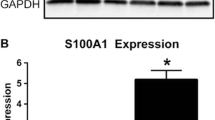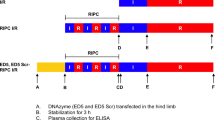Abstract
Purpose
We investigated whether increased expression of activated mitogen-activated protein kinase (MAPK) kinases 1 (MEK1) restores ischemic post-conditioning (IPostC) protection in hypertrophic myocardium following ischemia/reperfusion (I/R) injury.
Methods
C57Bl/6 mice received recombinant adeno-associated virus type 9 (rAAV9)-mediated activated MEK1 gene delivery systemically, then following the induction of cardiac hypertrophy via transverse aortic constriction for 4 weeks. In a Langendorff model, hypertrophic hearts were subjected to 40 min/60 min I/R or with IPostC intervention consisting of 6 cycles of 10 s reperfusion and 10 s no-flow before a 60-min reperfusion. Hemodynamics, infarct size (IS), myocyte apoptosis and changes in expression of reperfusion injury salvage kinase (RISK) pathway were examined.
Results
rAAV9-MEK1 gene delivery led to a 4.3-fold and 2.7-fold increase in MEK1 mRNA and protein expression in the heart versus their control values. I/R resulted in a larger IS in hypertrophic than in non-hypertrophic hearts (52.3 ± 4.7% vs. 40.0 ± 2.5%, P < 0.05). IPostC mediated IS reduction in non-hypertrophic hearts (27.6 ± 2.6%, P < 0.05), while it had no significant effect in hypertrophic hearts (46.5 ± 3.1%, P=NS) compared with the IS in non-hypertrophic or hypertrophic hearts subjected to I/R injury only, respectively. Hemodynamic decline induced by I/R was preserved by IPostC in non-hypertrophic hearts but not in hypertrophic hearts. rAAV9-MEK1 gene delivery restored IPostC protection in hypertrophic hearts evidenced by reduced IS (32.0 ± 2.8% vs. 46.5 ± 3.1%) and cardiac cell apoptosis and largely preserved hemodynamic parameters. These protective effects were associated with significantly increased phosphorylation of ERK1/2 and ribosomal protein S6 kinases (p70S6K), but it had no influence on Akt and glycogen synthase kinase-3β.
Conclusion
These results demonstrated that rAAV9-mediated activated MEK1 expression restores IPostC protection in the hypertrophic heart against I/R injury through the activation of ERK pathway.







Similar content being viewed by others
References
Haider AW, Larson MG, Benjamin EJ, Levy D. Increased left ventricular mass and hypertrophy are associated with increased risk for sudden death. J Am Coll Cardiol. 1998;32:1454–9.
Oka T, Akazawa H, Naito AT, Komuro I. Angiogenesis and cardiac hypertrophy: maintenance of cardiac function and causative roles in heart failure. Circ Res. 2014;114:565–71.
Shiojima I, Sato K, Izumiya Y, Schiekofer S, Ito M, Liao R, et al. Disruption of coordinated cardiac hypertrophy and angiogenesis contributes to the transition to heart failure. J Clin Invest. 2005;115:2108–18.
Ma LL, Li Y, Yin PP, Kong FJ, Guo JJ, Shi HT, et al. Hypertrophied myocardium is vulnerable to ischemia/reperfusion injury and refractory to rapamycin-induced protection due to increased oxidative/nitrative stress. Clin Sci (Lond). 2018;132:93–110.
Zhao ZQ, Corvera JS, Halkos ME, Kerendi F, Wang NP, Guyton RA, et al. Inhibition of myocardial injury by ischemic postconditioning during reperfusion: comparison with ischemic preconditioning. Am J Physiol Heart Circ Physiol. 2003;285:H579–88.
Donato M, Evelson P, Gelpi RJ. Protecting the heart from ischemia/reperfusion injury: an update on remote ischemic preconditioning and postconditioning. Curr Opin Cardiol. 2017;32:784–90.
Thuny F, Lairez O, Roubille F, Mewton N, Rioufol G, Sportouch C, et al. Post-conditioning reduces infarct size and edema in patients with ST-segment elevation myocardial infarction. J Am Coll Cardiol. 2012;59:2175–81.
Ovize M, Thibault H, Przyklenk K. Myocardial conditioning: opportunities for clinical translation. Circ Res. 2013;113:439–50.
Hausenloy DJ, Lecour S, Yellon DM. Reperfusion injury salvage kinase and survivor activating factor enhancement prosurvival signaling pathways in ischemic postconditioning: two sides of the same coin. Antioxid Redox Signal. 2011;14:893–907.
Hausenloy DJ, Tsang A, Yellon DM. The reperfusion injury salvage kinase pathway: a common target for both ischemic preconditioning and postconditioning. Trends Cardiovasc Med. 2005;15:69–75.
Hausenloy DJ, Yellon DM. Survival kinases in ischemic preconditioning and postconditioning. Cardiovasc Res. 2006;70:240–53.
Ramos JW. The regulation of extracellular signal-regulated kinase (ERK) in mammalian cells. Int J Biochem Cell Biol. 2008;40:2707–19.
Bueno OF, Molkentin JD. Involvement of extracellular signal-regulated kinases 1/2 in cardiac hypertrophy and cell death. Circ Res. 2002;91:776–81.
Boengler K, Buechert A, Heinen Y, Roeskes C, Hilfiker-Kleiner D, Heusch G, et al. Cardioprotection by ischemic postconditioning is lost in aged and STAT3-deficient mice. Circ Res. 2008;102:131–5.
Przyklenk K, Maynard M, Darling CE, Whittaker P. Aging mouse hearts are refractory to infarct size reduction with post-conditioning. J Am Coll Cardiol. 2008;51:1393–8.
Rehni AK, Dave KR. Ameliorative potential of conditioning on ischemia-reperfusion injury in diabetes. Cond Med. 2018;1(3):105–15.
Ferdinandy P, Hausenloy DJ, Heusch G, Baxter GF, Schulz R. Interaction of risk factors, comorbidities, and comedications with ischemia/reperfusion injury and cardioprotection by preconditioning, postconditioning, and remote conditioning. Pharmacol Rev. 2014;66:1142–74.
Hernandez-Resendiz S, Roldan FJ, Correa F, Martinez-Abundis E, Osorio-Valencia G, Ruiz-de-Jesus O, et al. Postconditioning protects against reperfusion injury in hypertensive dilated cardiomyopathy by activating MEK/ERK1/2 signaling. J Card Fail. 2013;19:135–46.
Yang XM, Proctor JB, Cui L, Krieg T, Downey JM, Cohen MV. Multiple, brief coronary occlusions during early reperfusion protect rabbit hearts by targeting cell signaling pathways. J Am Coll Cardiol. 2004;44:1103–10.
Darling CE, Jiang R, Maynard M, Whittaker P, Vinten-Johansen J, Przyklenk K. Postconditioning via stuttering reperfusion limits myocardial infarct size in rabbit hearts: role of ERK1/2. Am J Physiol Heart Circ Physiol. 2005;289:H1618–26.
Gao XM, Kiriazis H, Moore XL, Feng XH, Sheppard K, Dart A, et al. Regression of pressure overload-induced left ventricular hypertrophy in mice. Am J Physiol Heart Circ Physiol. 2005;288:H2702–7.
Li XM, Ma YT, Yang YN, Liu F, Chen BD, Han W, et al. Downregulation of survival signalling pathways and increased apoptosis in the transition of pressure overload-induced cardiac hypertrophy to heart failure. Clin Exp Pharmacol Physiol. 2009;36:1054–61.
Chen H. Intron splicing-mediated expression of AAV rep and cap genes and production of AAV vectors in insect cells. Mole Ther. 2008;16:924–30.
Chen BD, He CH, Chen XC, Pan S, Liu F, Ma X, et al. Targeting transgene to the heart and liver with AAV9 by different promoters. Clin Exp Pharmacol Physiol. 2015;42:1108–17.
Gao XM, Tsai A, Al-Sharea A, Su Y, Moore S, Han LP, et al. Inhibition of the renin-angiotensin system post myocardial infarction prevents inflammation-associated acute cardiac rupture. Cardiovasc Drugs Ther. 2017;31:145–56.
Ruze A, Chen BD, Liu F, Chen XC, Gai MT, Li XM, et al. Macrophage migration inhibitory factor plays an essential role in ischemic preconditioning-mediated cardioprotection. Clin Sci (Lond). 2019;133:665–80.
Sutherland FJ, Shattock MJ, Baker KE, Hearse DJ. Mouse isolated perfused heart: characteristics and cautions. Clin Exp Pharmacol Physiol. 2003;30:867–78.
van Vuuren D, Genis A, Genade S, Lochner A. Postconditioning the isolated working rat heart. Cardiovasc Drugs Ther. 2008;22:391–7.
Zhu M, Feng J, Lucchinetti E, Fischer G, Xu L, Pedrazzini T, et al. Ischemic postconditioning protects remodeled myocardium via the PI3K-PKB/Akt reperfusion injury salvage kinase pathway. Cardiovasc Res. 2006;72:152–62.
Gao XM, Liu Y, White D, Su Y, Drew BG, Bruce CR, et al. Deletion of macrophage migration inhibitory factor protects the heart from severe ischemia-reperfusion injury: a predominant role of anti-inflammation. J Mol Cell Cardiol. 2011;50:991–9.
Fang H, Lai NC, Gao MH, Miyanohara A, Roth DM, Tang T, et al. Comparison of adeno-associated virus serotypes and delivery methods for cardiac gene transfer. Hum Gene Ther Methods. 2012;23:234–41.
Pacak CA, Byrne BJ. AAV vectors for cardiac gene transfer: experimental tools and clinical opportunities. Mol Ther. 2011;19:1582–90.
Miyagi N, Rao VP, Ricci D, Du Z, Byrne GW, Bailey KR, et al. Efficient and durable gene transfer to transplanted heart using adeno-associated virus 9 vector. J Heart Lung Transplant. 2008;27:554–60.
Piras BA, Tian Y, Xu Y, Thomas NA, O'Connor DM, French BA. Systemic injection of AAV9 carrying a periostin promoter targets gene expression to a myofibroblast-like lineage in mouse hearts after reperfused myocardial infarction. Gene Ther. 2016;23:469–78.
Sun MH, Chen XC, Han M, Yang YN, Gao XM, Ma X, et al. Cardioprotective effects of constitutively active MEK1 against H2O2-induced apoptosis and autophagy in cardiomyocytes via the ERK1/2 signaling pathway. Biochem Biophys Res Commun. 2019;512:125–30.
Yang YN, Ji WN, Ma YT, Li XM, Chen BD, Xiang Y, et al. Activation of the ERK1/2 pathway by the CaMEK gene via adeno-associated virus serotype 9 in cardiomyocytes. Genet Mol Res. 2012;11:4672–81.
Dow J, Bhandari A, Simkhovich BZ, Hale SL, Kloner RA. The effect of acute versus delayed remote ischemic preconditioning on reperfusion induced ventricular arrhythmias. J Cardiovasc Electrophysiol. 2012;23:1374–83.
Galagudza M, Kurapeev D, Minasian S, Valen G, Vaage J. Ischemic postconditioning: brief ischemia during reperfusion converts persistent ventricular fibrillation into regular rhythm. Eur J Cardiothorac Surg. 2004;25:1006–10.
Vinten-Johansen J, Zhao ZQ, Jiang R, Zatta AJ, Dobson GP. Preconditioning and postconditioning: innate cardioprotection from ischemia-reperfusion injury. J Appl Physiol (1985). 2007;103:1441–8.
Bouhidel O, Pons S, Souktani R, Zini R, Berdeaux A, Ghaleh B. Myocardial ischemic postconditioning against ischemia-reperfusion is impaired in Ob/Ob mice. Am J Physiol Heart Circ Physiol. 2008;295:H1580–6.
Penna C, Tullio F, Perrelli MG, Moro F, Abbadessa G, Piccione F, et al. Ischemia/reperfusion injury is increased and cardioprotection by a postconditioning protocol is lost as cardiac hypertrophy develops in nandrolone treated rats. Basic Res Cardiol. 2011;106:409–20.
Katakam PV, Jordan JE, Snipes JA, Tulbert CD, Miller AW, Busija DW. Myocardial preconditioning against ischemia-reperfusion injury is abolished in Zucker obese rats with insulin resistance. Am J Phys Regul Integr Comp Phys. 2007;292:R920–6.
Tsang A, Hausenloy DJ, Mocanu MM, Carr RD, Yellon DM. Preconditioning the diabetic heart: the importance of Akt phosphorylation. Diabetes. 2005;54:2360–4.
Yang XM, Philipp S, Downey JM, Cohen MV. Postconditioning's protection is not dependent on circulating blood factors or cells but involves adenosine receptors and requires PI3-kinase and guanylyl cyclase activation. Basic Res Cardiol. 2005;100:57–63.
Funding
This work was supported by a key project of Xinjiang jointed program (U1903212) from the National Science Technology Ministry of China, an open project (No. 2018D04030) of Key Laboratory from Science and Technology Department of Xinjiang Uygur Autonomous Region, a project grant (No. 81870272) from National Nature Science Foundation of China and a “973” Preliminary program grant (ID 2010CB535013) from the National Science Technology Ministry of China.
Author information
Authors and Affiliations
Contributions
Conceived and designed the experiments and obtained funding support: X.M.G., Y.T.M. and Y.N.Y.; Performed the experiment: Y.C., F.L., X.M.G., B.D.C. and Z.X.Y.; Contributed reagents/materials/analysis: F.L., X.M.L., X.L.G., Y.H., Z.X.Y. and X.M.G.; Wrote the manuscript: Y.C., C.H.H. and X.M.G.; Revised manuscript for submission: Y.C. and X.M.G.
Corresponding authors
Ethics declarations
All applicable international, national and/or institutional guidelines for the care and use of animals were followed.
Additional information
Publisher’s Note
Springer Nature remains neutral with regard to jurisdictional claims in published maps and institutional affiliations.
Rights and permissions
About this article
Cite this article
Chen, Y., Liu, F., Chen, BD. et al. rAAV9-Mediated MEK1 Gene Expression Restores Post-conditioning Protection Against Ischemia Injury in Hypertrophic Myocardium. Cardiovasc Drugs Ther 34, 3–14 (2020). https://doi.org/10.1007/s10557-020-06936-8
Published:
Issue Date:
DOI: https://doi.org/10.1007/s10557-020-06936-8




